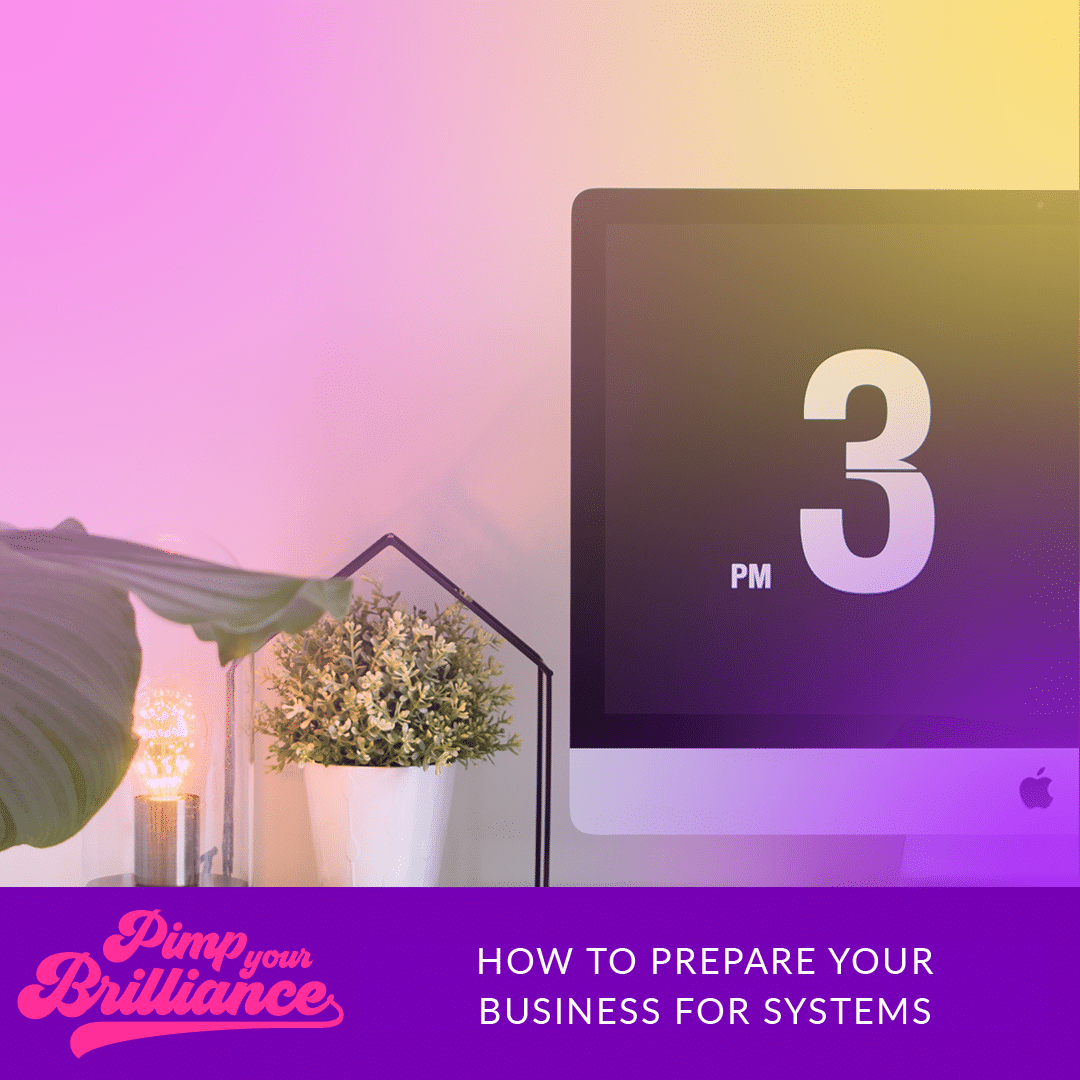
It is no secret that I am a systems nerd. I love planning and organizing information. I’m always looking for ways to make things more streamlined and require fewer mouse clicks from me.
I really like things to be efficient. So today’s episode is one I’m excited to record because I get to nerd out a little bit.
The thing about systems is you need them but it can be very overwhelming figuring where to start.
Do you need lots of fancy tools and software? Do you need a team? How do you know when your business is ready for systems?
To quickly answer those three questions, no, no, and from day one, but I don’t want to get ahead of myself.
Let’s start with the basics.
What are systems?
A system is a decided way, method, or process of doing something in your business.
Whether you realize it or not, your business already has systems because by definition, they are your specific way of doing work in your business.
Systems vs. Processes
Processes are a series of steps or actions involved in the way work is completed. Basically, processes are how you get stuff done in your business.
As you can see, processes are a component of your overall system. If systems are the recipe, processes are the steps.
You should have a process in place for every repetitive task used in your business.
Why do you need processes?
Systems allow you to delegate work and scale your business. Over time, this frees you up to take a vacation or gives you the mental space to think bigger picture in your business.
Even if you don’t aspire to have a huge team to manage, I bet you’d like to spend less time working in your business. Processes are how you make that happen.
Your business needs processes because…
- They eliminate guesswork. You always know the next step.
- They deliver repeatable results every time you follow the process.
- They make it easier to outsource or delegate work.
- They eliminate overwhelm by freeing up mental space.
- Documenting your processes helps you identify areas that can be improved or streamlined.
- They make it easier to find tools to automate parts of your workflow.
4 Steps to prepare your business for systems
Step 1. Figure out which systems you need to create
Your first step is to write down all of the systems that you need to create. You can do this by brainstorming the different buckets that make up your business.
Examples of business systems:
- Content marketing
- Social Media
- Customer service
- Accounting
- New client onboarding
- Order fulfillment
If you’re looking for a few other systems ideas, check out this post about 6 Must-Have Systems For Your Creative Business.
What activities does your business complete on a daily basis?
The goal here is to be as thorough as you can. Even if it seems like a simple or routine task.
Once you have all of your tasks listed, you need to determine three things:
- Is it required for your business to function?
- Is it a recurring task?
- Do you follow the same steps to complete it each time?
If your answer is yes to all three questions, it’s time to develop a process for those tasks.
If it’s not a recurring task but it’s required, that task can be added to your to-do list as a one off project.
If it’s not recurring or required, you need to evaluate why you’re doing it.
Step 2. Identify your D/W/M tasks (don’t forget quarterly tasks)
Every task in your business needs to be done at certain intervals. Some are required daily, others need to be done weekly, while certain tasks only come up once a month or even quarterly.
Next, you’ll need to decide how frequently tasks should be done. Go through your list task by task and add a D/W/M (daily/ weekly/ monthly) next to it. Don’t forget about quarterly or yearly tasks like taxes.
This is one part determining the proper interval for each task and one part finding the right schedule for your specific business. There isn’t a right or wrong here.
Step 3. Write out the steps in your process
By now you probably have a list of 10 to 20 processes that you need to create for your business. You don’t need to worry about documenting every process right. Start with one process.
What exactly does it take to complete that task start to finish?
Write out each step in your process. To make this easier, I suggest you set aside 30 minutes and go through the motions of doing the task so that you don’t miss any steps.
After you’ve brainstormed the overarching tasks you need to complete, you’ll need to start filling in the small details.
For example, the larger parts of publishing a podcast are recording, editing, and scheduling it. The smaller details are uploading it to Libsyn and generating the code to add a podcast player to a post in WordPress.
You aren’t aiming to have a 100% perfect process. The most important thing is to capture the beginning, middle, and end of the task you’re aiming to document.
Step 4. Follow the process
Finally, it’s time to try it out yourself and make sure there are no missing steps. The process that you documented is still rough. Don’t worry if you forgot a step, fill it in and keep going.
Commit to following the process. Over time you’ll find places that you can improve the process for efficiency.
Remember: your systems are a live document. You want to make sure you’re checking, updating, and improving them on an ongoing basis.
Bonus Step: Add your processes to a project management system
Now that you’ve defined the systems and processes that your solo business needs, it’s time to get your project management system set up.
Use your processes to create task templates for the different systems you’ve mapped out in your business. Once you’ve added in the individual steps, you can set deadlines based on the frequency that you need to complete the task. This is a simple way to make sure you’re using your processes and not missing steps.
Project management systems aren’t just for teams.
Solopreneurs can also benefit by utilizing the organization and project tracking provided by project management systems like Asana.
That’s why I created Asana for Solopreneurs.
This training will show you how to set up a free Asana account as your business’s headquarters to help you track, manage, and complete your essential tasks.

Here’s what’s included:
- Video walkthroughs of how to set up your Asana account
- The basics of Asana
- Setting up your Biz HQ
- Bonus: Pre-made Project Templates – You don’t need to create your projects from scratch use these templates as a starting point.
- Bonus: Done For You Processes – Use these fully created task workflows as the starting point for your processes and then tweak them to fit your business.
